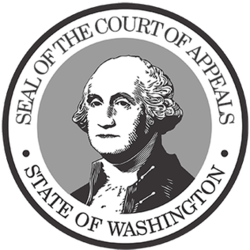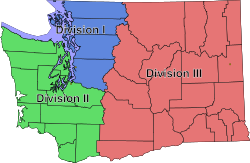History
As early as 1929, the Washington judiciary observed a need for an intermediate appellate court to relieve the heavy workload of the Washington Supreme Court. That year the state's Judicial Council suggested the establishment of such a court as a possible option for judicial restructuring. Nevertheless, the state legislature took no steps until the mid-1960s, when work began on a Court of Appeals.
The Washington citizenry adopted a Constitutional Amendment on November 5, 1968, which authorized the legislature to create a Court of Appeals and to define its composition and jurisdiction. On May 12, 1969, the legislature passed the enabling act that established a Court of Appeals with three divisions and a total of twelve judges. Governor Dan Evans appointed the initial twelve judges with the judges all facing election at the general election of 1970 and with each elected judge initially serving terms of two, four or six years determined by lot. [1]
Divisions
Division II
Division II sits in Tacoma and hears appeals from the counties of Clallam, Clark, Cowlitz, Grays Harbor, Jefferson, Kitsap, Lewis, Mason, Pacific, Pierce, Skamania (see note, infra.), Thurston and Wahkiakum.
Division III
Division III sits in Spokane and includes the three-fifths of the state's land area that lies east of the Cascade Range. In addition to the state's second largest city, Spokane; it embraces the regional cities of Yakima and the Tri-Cities of Kennewick, Pasco, and Richland. It hears appeals from Adams, Asotin, Benton, Chelan, Columbia, Douglas, Ferry, Franklin, Garfield, Grant, Kittitas, Klickitat (see note, infra.), Lincoln, Okanigan, Pend Oreille, Spokane, Stevens, Walla Walla, Whitman and Yakima counties.
Other areas
Skamania County is in Division II; Klickitat County is in Division III. These counties are sparsely populated, so do not qualify for their own Superior Court judge. They must share one Superior Court Judge. When the judge presides in Skamania County, Division II opinions are followed. When the judge presides in Klickitat County, Division III opinions are followed. When the Divisions issue conflicting opinions, practitioners must be careful to follow/cite from the appropriate appellate division.
This page is based on this
Wikipedia article Text is available under the
CC BY-SA 4.0 license; additional terms may apply.
Images, videos and audio are available under their respective licenses.


